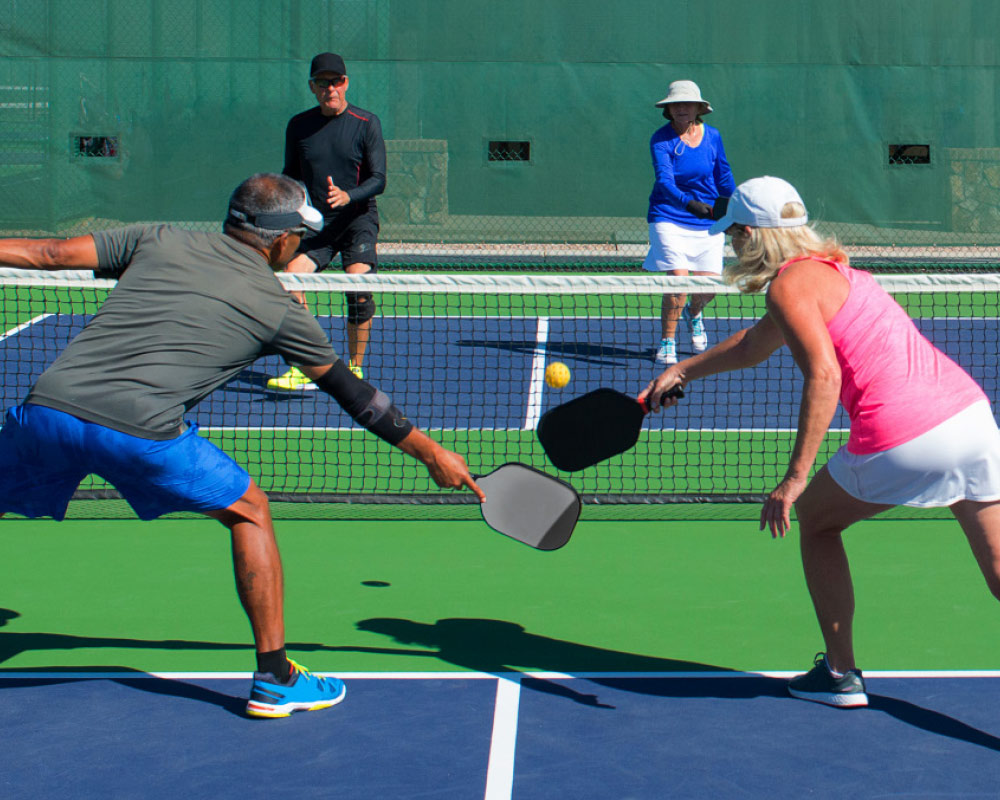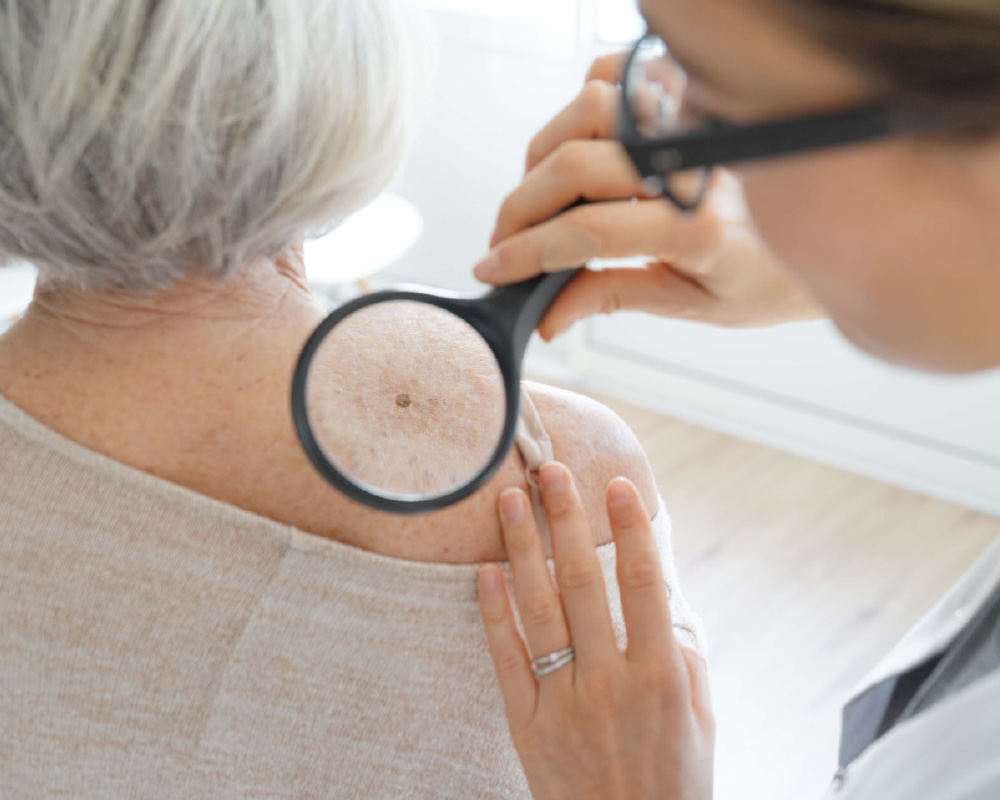It’s a fact of life that we’re all getting older, and that means new concerns for our health. How do you ensure a healthy lifestyle for years to come? We asked the experts on aging gracefully.

As we age, parts of our body slowly deteriorate, which can lead to swelling and pain.
At the same time, wrinkles begin to show and new spots often emerge, bringing concerns along with them.
So, how can we make sure we’re aging in a healthy manner?
“I know patients don’t like to hear that they’re aging,” says Dr. Vikram Khanna, founder of Dermatology Specialists of Illinois. “It’s almost like a dirty word. They don’t like to hear about age spots – that’s why I call them wisdom spots. But we’re all aging. It’s not a dirty word. We’re living longer than ever. We’re going to have to embrace our aging skin. We should just know more about it and get checked when we need to.”
Dr. David Morawski, a board-certified total joint surgeon with Fox Valley Orthopedics, has a similar opinion.
“Senior patients need to realize that the aging process is normal, to start having aches, pains and stiffness in joints,” says Morawski. “But when it really starts to affect the quality of your life and it starts to affect your mental well-being, then there are simple answers that we have that we can use to restore you to a very normal lifestyle, which then brings happiness back into your life, and a lot of times more health – not just psychological health, but physical health.”

Signs of Aging Joints
How do you know if the pain you’re feeling is abnormal or simply a sign of agin … ahem, maturing?
Morawski is quick to point out that at any age, a person can simply twist an ankle or sprain a ligament, which will obviously cause some discomfort. But there are no real guidelines for pain due to aging because everyone reaches an arthritic condition at different ages, he adds.
And that’s what disables people the most – arthritis, or the inflammation of joints.
“What can cause a joint to be inflamed could be a multitude of things,” Morawski says. “The most common is the deterioration of the articular covering of the end of the bone, the articular cartilage. The raw end of the bone is exposed to both sides, so the femur and tibia in the knee, or the pelvis and head of the femur in a hip. That cartilage loss produces pain when the two bones rub together. That’s degenerative arthritis.”
There are other types of arthritis – septic arthritis, caused by a bacterial infection in the joint; gout, which is a buildup of chemicals in the blood that deposits in the joints; and trauma arthritis caused by multiple injuries to the same joint.
But ultimately, arthritis leads to pain from bone rubbing against bone, and when the pain becomes too much, it often stops people from staying active.
That, in turn, has a negative effect on a person’s overall health and wellness.
“My life has been dedicated to getting patients up and walking again because I replace hips and knees that are arthritic from wear and tear, possibly old trauma or maybe just genetic predisposition,” Morawski says. “As we age, things slowly begin to deteriorate, which leads to pain and swelling. Patients wish they could be more active, and when they get less active, that affects their whole well-being. I deal with patients who get depressed because they’ve had to give things up that gave them simple joys: they played tennis, but now that they’re in their 70s, they can’t anymore. Or, they can no longer enjoy taking their dog, who adores them, on walks. They feel the world is becoming a smaller circle for them; they can’t get out and do things they love.”
The good news is that there are many treatment options. Sometimes anti-inflammatories like ibuprofen can stave off pain; other times, cortisone injections or hyaluronic acid supplements can help lubricate the joints, which results in less discomfort and more mobility.
Newer injection therapies are available, too, though they’re not covered by insurance.
“Platelet rich plasma, or PRP, is a regenerative medicine technique where we take blood from the patient, concentrate the good cells from the blood that help us to heal – like the growth proteins – and we inject those in the arthritic joint,” Morawski says. “Or, we can take cells from fat in our body, suck that out, isolate the mesenchymal stem cells, and that can be injected into the joints with hopes of those cells turning into cartilage cells and helping the joint repair itself.”
Even if joint replacement surgery is necessary, the overall treatment goal is better mobility, because that’s the way to live a healthy lifestyle.
“Humans are made to be active people,” Morawski says. “We weren’t born to be in a wheelchair or sedentary. In order to do that, you need healthy, pain-free joints.”
Don’t wait until you’re in excruciating pain before you decide to see a specialist.
“My recommendation is, when you notice more difficulty going up and down stairs or putting your shoes and socks on, come see us,” he says. “A lot of times, the first thing we notice in patients who have bad hips is they can’t rotate their hip high enough to get their shoes and socks on. Those are little cues that you might have a hip problem, or if you can’t go down the stairs, you have a knee problem.”

Exercise – And Watch What You Eat
Eating healthy is key to joint health. Morawski often speaks about the prevention of inflammation, and that starts by watching what you eat.
In particular, he cautions patients to stay away from glutens, caffeine and alcohol, which are very inflammatory, and instead focus on the foods that can help your body.
“There are a lot of anti-inflammatory foods that can help with inflammation,” he says. “Turmeric is a spice that is quite healthy and is anti-inflammatory in property. There’s a lot of other foods, mostly healthy vegetables, that will promote healthier joints.”
Though you can supplement with turmeric for healthier joints, taking a pill to cover up bad eating habits won’t work in the long run.
“You can’t ignore the obesity we have as we age,” he says. “Having a healthy weight that we carry on our body on a day-to-day basis will only help us preserve our joints longer. Hips and knees are weight-bearing joints, and if we overload those joints, they’re going to fail, and they’re going to fail quicker and keep you from moving well.”
Exercising is just as important, says Dr. Marc Angerame, a fellowship-trained joint replacement orthopedic surgeon at Barrington’s Illinois Bone and Joint Institute. He specializes in hip and knee replacement and treatment of arthritis. Angerame regularly counsels patients on how to prevent the advancement of arthritis.
“The best prevention for knee and hip arthritis is maintaining a healthy weight and remaining active,” he says.
As his patients get older, Angerame counsels them that the most important thing they can do is to maintain the best cardiovascular and cerebrovascular fitness possible.
“That’s daily exercise; that’s daily walking; that’s pickleball,” he says. “As we get past the age of 50, the idea of building muscle isn’t a foregone conclusion, but it’s more difficult to do. So, you’re more in a maintenance zone in that point in time. The old adage, ‘if you don’t use it you lose it,’ is true. Blood vessels that maintain homeostasis – or normal working condition – require daily walking, daily exercise.
“Where orthopedics come into play is keeping joint health along with muscle health – and the one cannot function without the other,” he adds. “When it comes to arthritis and healthy aging, if your ability to maintain proper cardiovascular fitness comes into question because you can’t ride a bicycle, you can’t play those nine holes of golf, something has to be done about it.”

Treatments for Signs of Aging
Around age 65 – think close to retirement age – the body starts to need a different type of conditioning, says Dr. Jeremy Oryhon, a fellowship-trained orthopedic surgeon at Barrington’s Illinois Bone and Joint Institute.
“When people are aging, they get muscle weakness, and it’s not their fault. It’s part of aging,” Oryhon says. “You lose muscle units, and you lose the fast-twitch muscles first – those are your kind of explosive, power muscles – and that has consequences for being able to catch yourself when you fall quickly or just being more prone to falls.”
Sometimes people get offended when Oryhon says their muscles are weak, arguing that they walk every day.
“That’s not the point,” Oryhon says. “If you’re not spending time specifically strengthening, especially eccentric strengthening, your muscles, walking isn’t enough. Most people fall if they’re stepping down a curb rather than tripping over it because they just don’t have that eccentric strength.”
If you or an elderly loved one experience times of imbalance, groin pain or hip pain, it might be time for an evaluation.
“If you’re already noticing a limp or shuffling feet, that’s probably the best time to start some therapy and get on a program because that might stave off a fall,” Oryhon says.
Therapists might start with an eccentric exercise – focusing on the lower part of your gait. Take a quick step up, and then count to five as you slowly lower yourself back down to your original step.
Aging individuals should also focus on strengthening their hip abductors and the IT band, also known as the iliotibial band. This thick band of tissue runs along the outside of your leg from your hip to your shinbone.
“Keeping arthritic joints active is the best thing for them until they’re too painful for activity, and that’s when we come in to help guide them in that process,” Oryhon says.
Patients often ask if taking collagen or hyaluronic acid supplements are beneficial.
If it helps a patient deal with pain, then by all means, take supplements, Angerame offers. Those types of supplements present little risk, other than cost and the potential for allergic reaction.
But that doesn’t necessarily mean they “work.”
“Arthritis, pure and simple, is the loss of cartilage over time,” Angerame says. “There is no medication, no supplement and no treatment that has been proven to be effective in regrowing or staving off the loss of cartilage. The alternative supplement treatment industry is a multi-billion-dollar industry that has no scientific proven benefit.”
However, he and Oryhon believe that there may be a placebo benefit.
“It’s just basically a psychological benefit – and you can’t totally discount that – but there’s not a physical change benefit,” Oryhon says. “My little thing I tell patients is this: if you’re bald and you eat hair, you’re not going to grow hair. If you eat cartilage – and those supplements are forms of cartilage – you’re not going to grow cartilage.”

Healthy Skin
Another telltale sign of aging is the appearance of new and changing spots on the skin, says Khanna, a board-certified dermatologic surgeon at Dermatology Specialists of Illinois, with clinics in Algonquin, Lake Barrington, Huntley and Woodstock.
Age spots – what Khanna dubs wisdom spots – start appearing around age 30, and they often increase in number. They’re typically grayish to brownish with a rough, dry texture, and while they can present concerns if they’re particularly dark in color or irritating, the majority of these seborrheic keratosis spots are very common and unconcerning from a medical standpoint, Khanna says.
Similarly, cherry angiomas are small, shiny, smooth symmetric spots that are cherry red in color. Those also are very benign, Khanna says.
Then there’s senile purpura, a common condition that typically affects patients 60 and older. Spontaneous purple spots will show up on their hands or arms, even though they often don’t recall bumping into anything, Khanna says.
“Their blood vessels are bursting under the skin because their collagen isn’t as firm as it used to be and it doesn’t support the skin as well,” Khanna says. “One key feature is they disappear within seven to 10 days.”
Arnica supplements in topical or pill form can be helpful for purpura, as can vitamin C, Khanna adds.
These are all normal skin conditions that come with age, Khanna says. And some can be remedied with laser treatments, Botox and other dermatological treatments.
Yet, people know that certain spots can be signs of skin cancer, and the new appearance of spots often has them worried.
So, how do you know the difference between an age spot and a cancerous mole?
“By the time we’re in our 30s and 40s, we’re really at risk of skin cancer,” Khanna says.
“As we get older, our public needs to be a little more educated on these things, because these can save your life.”
First, know that there are three common types of skin cancer, and they each present differently, Khanna says.
These common skin cancer types are:
- Basal cell carcinoma presents as a red spot or sore that never seems to fully heal.
- Squamous cell carcinoma, the second most-common form of skin cancer, looks like a wart or rough patch that is persistent or slowly enlarging. It might look like it’s temporarily getting better, but it comes back in the same place, Khanna says.
- Melanoma, the most serious form of skin cancer, can be discovered by looking for the ABCDEs:
A – Asymmetry: Melanoma lesions, usually brown in color, will have an asymmetrical shape; one-half of the mole will not match the other.
B – Border: Scalloped or jagged edges around a mole are worrisome; normal moles are smooth and round.
C – Color: Dark colors are not good; black or dark brown spots should be inspected, as should unevenly colored moles.
D – Diameter: If a mole is 6 millimeters or greater in diameter – about the size of a pencil eraser – it is more at risk of being cancerous.
E – Evolution: If a mole is changing in color, growing, itching or bleeding, you should have it checked out by a primary care doctor or specialist.
Take the time to check your skin, or your loved one’s skin, for these types of cancerous spots, especially on the back or parts of the legs and arms that aren’t easily visible.
“And if something doesn’t seem right to you, you can get it checked,” Khanna says.
Dry skin is another ailment that persists with aging.
“Older skin dries out more easily,” Khanna says. “A common complaint of patients is they’re very itchy, especially in winter months. They need to moisturize a lot more, even if that might not have been their habit.”
A cool mist humidifier can help keep moisture in the air, or if you have a central humidifier, dial it up to 40%, Khanna says.
“That’s even better than medicine: changing their ambient atmosphere,” he says. “You can’t change the fact that your skin doesn’t maintain the moisture that it used to.”


















































